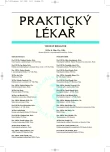Burnout and Czech general practitioners
Authors:
B. Seifert; J. Vojtíšková
Authors‘ workplace:
Přednosta: MUDr. Bohumil Seifert, Ph. D.
; 1. lékařská fakulta
; Ústav všeobecného lékařství
; Univerzita Karlova v Praze
Published in:
Prakt. Lék. 2008; 88(7): 398-401
Category:
Of different specialties
Overview
Introduction:
Burnout syndrome was described by Freudenberger in 1975. Burnout is a state of emotional and physical exhaustion caused by excessive and prolonged stress. It is often described as a result of unbalance between expectations and reality. The definition includes a lost of professional interest and motivation. Medical professionals more suffer from burnout than the average population. General practitioners are dealing with the wide range of problems and medical conditions, often difficult to solve, with own doubts and uncertainty. They are with their usually altruistic attitude and their wide range of responsibilities therefore at high risk.
Aims and methods:
The aim of the article is to describe specific aspects of burnout among Czech general practitioners and possible ways of its prevention. A comprehensive literature review on burnout was used to prepare a focus group comprised of general practitioners. The focus group discussion was organized during a national congress of Czech Society of General Practice in 2007. Participants produced their own solutions based upon personal experiences of dealing with burnout. The discussion was facilitated by academic practitioners and monitored. The outcomes were elaborated and distributed to participants for feedback.
Results:
The focus group participants agreed on the high risk of burnout among general practitioners in the Czech Republic and on the need to look for solutions to prevent it. Some critical causes of burnout were identified. The importance of patient safety was emphasized. General practitioners are responsible not only for own professional performance but also for the nurse and other staff, potentially influenced by burnout. The role of professional organizations in burnout prevention was discussed. It was found difficult to design general strategies of burnout prevention because the causes are often individual. On the other hand burnout should stay on the agenda of medical organisations.
Key words:
burnout, general practitioner, evidence based medicine.
Sources
1. Honzák, R. Prevence burnout syndromu. Lékařské listy 2008, 8, s. 28-31.
2. Haškovcová, H. Péče o ošetřující týmy pomáhající profese o sobě. Prakt. lék. 2000; 80(4), s. 228-229.
3. Zacharová, E. Syndrom vyhoření – riziko ohrožující zdravotnické pracovníky. Interní medicína pro praxi 2008, 10(1), s. 41-42
4. Lee, F.J., Stewart, M., Brown, J.B. Stress, burnout and strategies for reducing them: what’s the situation among Canadian family physicians? Can. Fam. Physician. 2008, 54(2), p. 234-235.
5. Kushnir, T., Levhar, C., Cohen, A.H. Are burnout levels increasing? The experience of Israeli primary care physicians. Isr. Med. ASIC. J. 2004, 6(8), p. 451-455.
6. Vela-Bueno, A., Moreno-Jimenez, B., Rodriguez-Munoz, A. et al. Insomnia and sleep quality among primary care physicians with low and high burnout levels. J. Psychosom. Res. 2008, 64(4), p. 435-442.
7. Głebocka, A, Lisowska, E. Professional burnout and stress among Polish physicians explained by the Hobfoll resources theory. J. Physiol. Pharmacol. 2007, 58, Suppl. 5(Pt 1), p. 243-252.
Labels
General practitioner for children and adolescents General practitioner for adultsArticle was published in
General Practitioner

2008 Issue 7
- Metamizole vs. Tramadol in Postoperative Analgesia
- What Effect Can Be Expected from Limosilactobacillus reuteri in Mucositis and Peri-Implantitis?
- Metamizole at a Glance and in Practice – Effective Non-Opioid Analgesic for All Ages
- Memantine in Dementia Therapy – Current Findings and Possible Future Applications
Most read in this issue
- Pernicious anemia
- Fractures that are hard to diagnose in the skeleton of a child
- V.A.C. therapy in the treatment of soft-tissue defects
- Chlamydia pneumoniae
